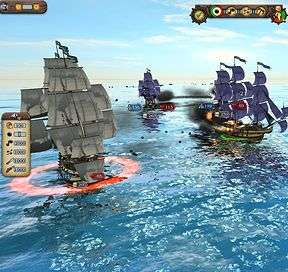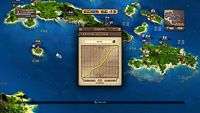Port Royale 3 – Review
by Stu
|
 Kalypso’s latest release in the Port Royale franchise branches out to consoles for the first time, bringing a welcome injection into the rather sparse offering in the trade ‘em up suite of games currently on offer. Set, as all good pirate games are, in the Caribbean of the 17th Century, it promises a new world to conquer and multiple ways of doing so… well, two, really. Split into two campaigns – trader and adventurer – the story sees you rise to power either via economic success as a merchant or through domination as a naval power. There is also a free-play mode whereby no over-arching story or mechanic has favour and you are free to do whatever you will.
Kalypso’s latest release in the Port Royale franchise branches out to consoles for the first time, bringing a welcome injection into the rather sparse offering in the trade ‘em up suite of games currently on offer. Set, as all good pirate games are, in the Caribbean of the 17th Century, it promises a new world to conquer and multiple ways of doing so… well, two, really. Split into two campaigns – trader and adventurer – the story sees you rise to power either via economic success as a merchant or through domination as a naval power. There is also a free-play mode whereby no over-arching story or mechanic has favour and you are free to do whatever you will.
Effectively being six-hour tutorials, each campaign will go into great detail about the gameplay mechanics of the trading or combat aspect. Yes, you read it right, six-hour tutorials! This is not a quick game and although a lot of the campaigns are not feeding you facts or information constantly, as some checkpoints take a fair while to reach, there is still a fair bit to take in. Port Royale 3 is all about strategy, planning and patience. Having raced to get things done, and failed miserably, I restarted multiple times until finally getting into the swing of things and the pace of the game.
If you’ve ever played Sid Meier’s Pirates! then when you first see the map it’ll be instantly familiar. In fact, Port Royale 3 and Pirates! have a number of traits that could make them family in a fashion, although Pirates! is the cool one and Port Royale would be the one that grows up to be an accountant (apologies to all of you cool accountants out there!). There is little light relief in the game and it makes no bones about it either. This becomes clear through the rather functional video tutorials embedded into the game where a text/audio description will not suffice. This is an enjoyable but straight-laced game which may disappoint fans who enjoy the humour of Kalypso’s other sim-game, Tropico.
 Whether you decide to become the Warren Buffett or the Long John Silver of the Caribbean, you’ll spend 70-80% of your time on the tactical map. Whilst in this screen you are able to scroll around the map, jump to any convoys you have, perform various tasks in towns and cities as well as setting up battles. A mini-map of the whole Caribbean sits on the hud along with the nations and their state of diplomacy, your wealth, experience, date and rate of time passage. As you play through the game and your wealth/assets rise you gain levels in rank and this, in turn, opens up new options within the game, from the ships you can buy through to the actions you can perform on behalf of other countries.
Whether you decide to become the Warren Buffett or the Long John Silver of the Caribbean, you’ll spend 70-80% of your time on the tactical map. Whilst in this screen you are able to scroll around the map, jump to any convoys you have, perform various tasks in towns and cities as well as setting up battles. A mini-map of the whole Caribbean sits on the hud along with the nations and their state of diplomacy, your wealth, experience, date and rate of time passage. As you play through the game and your wealth/assets rise you gain levels in rank and this, in turn, opens up new options within the game, from the ships you can buy through to the actions you can perform on behalf of other countries.
It is from this main map that you command your convoys around the Caribbean. You can form a fleet consisting of a single ship but as you progress through the game you will need multiple ships in a convoy to haul your stock around, or if going for the military side of things, transporting your swashbuckling men and their weapons. When creating a convoy you are able to name it, although I kept mine pretty dull and functional with names like ‘Port Royale Supply’, but when the game generated a convoy called ‘Darkstar One’ (a space combat sim I enjoyed) I had to keep that and decided to make that my fighting force. Although a convoy can consist of multiple ships (I had thirteen in one, to bleed dry pirate hideouts) only three per convoy can be chosen as warships and taken into battle. You can allow the AI to determine the best warships for the job or manually pick them, should you desire. You can then man the ships with additional sailors, weapons (muskets or cutlasses) and types of shot for your cannons. The more men you have on your fighting escort, the quicker the cannons will reload during a battle – the benefits of that being obvious – but paying all of those additional bodies will cost so, once again, you have to be a little clever with your resources to ensure your warband doesn’t negate your profits or indeed bankrupt you.
 |
 |
 |
 |
 |
 |
Convoys are headed up by a Captain who will gain experience over time – a very long time. Depending on what your Captain gets up to will determine his levelling up of six abilities. Combat will likely increase his attack, cannon and repair skills with trading pushing up his trading skills and, finally, the line of sight skill is raised by patrolling. Captains can pay for trading in taverns when a teacher of a skill-set happens to wander in, but it is very costly. Each skill has a maximum of five levels. Keeping convoys alive and switching ships in and out are the key to holding on to a Captain as you’ll lose him if you disband it or lose the ships in combat.
 When you have your convoy, you then choose a destination by hovering over a town and choosing to approach. Kalypso have given context-sensitive command mappings so, for instance, pressing B in open water will direct the convoy to patrol (taking out any hostile ships that enter its field of vision) but the same button over a town or ship turns it into the attack command. This causes issues when trying to set up a patrol outside a town to stop enemy attacks on it as, more often than not, the commands will lasso to the town or a nearby ship and on multiple occasions it ended up costing me dearly in both ships and reputation.
When you have your convoy, you then choose a destination by hovering over a town and choosing to approach. Kalypso have given context-sensitive command mappings so, for instance, pressing B in open water will direct the convoy to patrol (taking out any hostile ships that enter its field of vision) but the same button over a town or ship turns it into the attack command. This causes issues when trying to set up a patrol outside a town to stop enemy attacks on it as, more often than not, the commands will lasso to the town or a nearby ship and on multiple occasions it ended up costing me dearly in both ships and reputation.
That niggle aside, Kalypso have made good use of the near-mandatory wheel function so, without having to leave the main map, you can hover over a town and pull up a wheel to gain access to the town information and trading screens.
In all there are sixty towns in Port Royale 3 plus any number of random locations where pirates may set up shop. Each town produces five of the twenty tradable commodities and production hubs can tend to cluster making for some interesting trade routes. In addition to offering trading facilities, towns also have a number of buildings that offer services or functions such as the tavern for side-quests and deals or the shipyards for repair and purchasing of new ships.
Towns are also where the other major part of the resource and trading elements take place as you can buy a building permit and create your own businesses. The businesses you are allowed to have match those of the five goods generated by the town and some, like tobacco plantations, require nothing but employees to create the raw material whereas others, such as a rum distillery, requires the import of other goods. Businesses are a great way to invest cash in a safe environment as, no matter what happens when nations war and take over towns, your businesses are not affected. That said, if your reputation with a nation is so poor that you can’t access the docks then your businesses will have to rely on other traders to get their goods out there.
As you accumulate wealth you can expand your convoys and, as controlling multiple ones would get too confusing, you can automate them with a wizard tool. All you need to do is select your towns you wish the convoy to visit, select a role for the convoy to play – this could be emptying your warehouse of produced goods, obtaining supplies for building more businesses or your raw materials or they could be runs purely for profit with buying and selling left up to the AI. Here Kalypso have really shone and within minutes I had totally reconfigured a rather large array of ships into more streamlined routes after a period of expansion across multiple towns. Naturally, you can also set up a trade route with custom settings although this isn’t explained too well and, despite my best efforts, the convoy would deactivate at the first port but not tell me what was wrong in my configuration. After several attempts I just gave up on that and reverted to AI presets.
 Keep trading well and doing odd-jobs to help the local economy (and respective owning country) and you could be put in the position of administrator over a town. Should that happen then you effectively take over the town and become responsible for maintaining the growth and defense of it. This then opens up the options of building a manor and gaining access to further information about ship movements and random items, such as castaways, by marrying a Viceroy’s daughter.
Keep trading well and doing odd-jobs to help the local economy (and respective owning country) and you could be put in the position of administrator over a town. Should that happen then you effectively take over the town and become responsible for maintaining the growth and defense of it. This then opens up the options of building a manor and gaining access to further information about ship movements and random items, such as castaways, by marrying a Viceroy’s daughter.
Inevitably you will at some point encounter the Caribbean blight that are the pirates. The AI is clever enough to work out when you have a route setup and if you do nothing then the same trade route will get repeatedly plundered. Should you add a fighter escort of decent quality then the attacks may get deterred, however initially this is quite tricky to manage and you may have to silently fume as, yet again, your pinnace is plundered of its goods.
Should you decide to make a stand against the aggressors or just fancy a bit of a scrap with another country then you assign your convoy three escort ships and enter battle. The battles in Port Royale 3 are very reminiscent to the naval combat in Empire: Total War and Pirates! so if you’re a veteran of either game then it won’t take long to get the hang of things. As in Empire, you are offered the choice of an automatic resolution to the conflict (taking into account the stats of each fleet) or manually engaging the enemy.
Entering a manual battle takes you to a scenario with your ships pitted against the enemy. You control the movement of one ship but can leap between the others. In addition you are able to issue commands to the other ships such as attack my target, defend or surrender. As with the main map you have an option to zoom in and out to quickly take stock of the battle should you split from the main scrap. When engaging in combat, wind comes into play as well as shallow areas onto which you can get snagged or run aground. As per Pirates! and Empire you can stock up on grapeshot and chained shot for your cannons, there is also a boarding mode whereby you can ram an enemy ship and your crew will duke it out with the opponent. A successful board will mean you get to plunder the ship after the battle, otherwise the other method of winning is to sink the enemy and forgo any plunder. This is less of an issue if you are a trader as countries will pay handsomely for removing pirate ships from the seas, however if taking up the life of a pirate then you will need to plunder to pay for your repairs and crew.
 |
 |
 |
 |
 |
 |
The battles can be quite protracted, particularly in later stages where the hit points on ships are large, and at times it feels a bit clunky, particularly the directional control of the ships that often try to do their own thing. There isn’t anything fundamentally different between the way combat works in this or Pirates! or even Empire: Total War, but it doesn’t feel as slick or as fun. In fact, for most battles, I ended up auto-resolving them as it was too much hassle and I only intervened if I was slightly worse off in terms of stats against my opponent so ran the risk of a loss.
Sadly, ship to ship combat is the most exciting part. Engaging a town or pirate hideout is particularly dull. When destroying a town’s defenses you need to manoeuvre your ships into position and whilst this could open up a whole interesting tactical debate there are three spots on the map per tower, one for each of your three ships. You don’t even get to fire as that is all automated, all you can do is watch as the cannon volleys fly between the ships and the defensive towers with health counters slowly dropping. Time to make extensive use of the ‘fast forward’ ability. Using the left trigger you can switch (at almost any point in the game) between 1x speed and 0.1x speed – useful for fine detail management when a lot is going on, but using the left bumper applies 10x speed for as long as it is pressed. This helps immeasurably when staring at long automated trade routes or very dull town battles.
Finally, the towers fall and it is time to move in for the kill and plunder the town. Unfortunately this is even less interesting than the tower attack as there is just one space and once again you take no part in the land battle, you just sit and watch a few pixels fighting in a cloud of dust until either you or the town has no fighters left.
 Graphically, the game won’t blow you away with particle effects or anything swish like that. As with most serious-minded sim games, the attention to detail is in the mechanics rather than the graphics but that isn’t to say that the game looks ugly. The campaigns host some beautiful pastel-styled cut scenes at certain plot points and the user interface is mostly unobtrusive and well thought out. Details are added when zooming into the map, such as random animals and birds scattered about the landscapes but the ships look similar and with the top-down view of the towns it is tough to pick out one building from another when it starts getting crowded for space. Don’t get me wrong, the game isn’t ugly but it hasn’t really gone any further than it has needed to in order to be functional.
Graphically, the game won’t blow you away with particle effects or anything swish like that. As with most serious-minded sim games, the attention to detail is in the mechanics rather than the graphics but that isn’t to say that the game looks ugly. The campaigns host some beautiful pastel-styled cut scenes at certain plot points and the user interface is mostly unobtrusive and well thought out. Details are added when zooming into the map, such as random animals and birds scattered about the landscapes but the ships look similar and with the top-down view of the towns it is tough to pick out one building from another when it starts getting crowded for space. Don’t get me wrong, the game isn’t ugly but it hasn’t really gone any further than it has needed to in order to be functional.
The amount of information that is packed onto the screen has been very well managed and the use of clear iconography to indicate needed goods, states of emergency, etc could well have been the difference between game making and game breaking. In fact I’ve not been impressed with a console strategy/management game UI/controller scheme in a long time, let alone one as complex as Port Royale 3 is underneath the shallow trading sim skin, but the game gets a big tick in that box and a nod of approval too. Almost all information is no more than a couple of presses away at most and that can be key to staving off monotony or needless loading screens transitioning from map to town.
The audio tracks don’t fare so well, unfortunately. Although all of the tutorials are voiced and even have video accompaniment, the soundtrack is very repetitive as is the in-game dialogue. Each town only has one phrase to describe a plethora of potential issues. For instance when the ‘narrator’ states “Cast your eye on Port Royale” he could mean:
- My warehouse is full
- My warehouse is lacking raw materials for my businesses
- My businesses need more people
- There is an event affecting the town, like an epidemic, a drought, fire, etc
- The town is under attack
 |
 |
 |
 |
 |
 |
When you have a presence in a number of towns then the game becomes a never ending stream of one-line warnings. When speeding time to generate cash reserves or because you are feeling a little lazy and letting the AI do all of your convoy work then it gets very irritating very quickly. The soundtrack music is also not massively varied. For a game that demands hours upon hours to get anywhere near a successful playthrough, then it would have been sensible to have more than an hour or two of music on loop. I could be wrong, and it could just be the sheer amount of time I’ve sunk into it that makes it seem lacking, but I doubt it. In fact, towards the end I played my own music from a memory stick as I could almost hum the entire soundtrack by then. Sinking pirate ships to the sound of Blood Sugar by Pendulum wasn’t quite what I had in mind at the beginning of this review!
Pros- Trading sim that is complex enough to satisfy the needs of console gamers, generally starved of this type of game
- Great UI and lots of thought around trading mechanics such as dynamic supply-and-demand affecting prices
- The two campaigns work as in-depth tutorials to ready you for having a punt at the free game mode
- Multiple methods of play-style from trader to privateer to pirate.
- Unlike the PC version, this lacks a multiplayer mode
- Battles are not particularly exciting, especially town/pirate bases
- Audio is very limited in terms of diversity
- Very dry and straight-laced game which will definitely not appeal to some gamers
Port Royale 3 is a game that requires patience. Nothing comes quickly and, whichever way you choose to play, it could be some time before you feel you are making good headway. By the same token, this is something a number of console gamers have been screaming out for. It’s about time a decent sim like this hit the consoles and, sure there are some cutbacks - the map isn’t always a smooth scroll and there is no multiplayer - but the core essence of the trading sim lives and breathes and is great fun to play should have the time and patience to sink into it.
I may not have been totally enamoured by the combat but then, thanks to the economic method of taking over towns, I rarely have to get embroiled thanks to auto-resolution and my play-style. Similarly, another player could easily use combat as their play-style of choice and utilise the AI to avoid excessive trading. For a game that tries to widen its audience by appealing to both sim and tactical combat gamers I think it just about manages it.
Dodgy Disney-like box art aside, Port Royale 3 delivers everything it promises on the box and is a solid recommendation for anyone who is lacking a PC but enjoys this genre. It may even scratch the itch of the Pirates! fans if they can accept a drier, less humourous version of the Sid Meier classic.
Last five articles by Stu
- When A Choice Isn't Really A Choice At All
- Best of 2013: Next-Gen: #Fail
- Deadfall Adventures - Review
- Assassin's Creed IV: Black Flag - Review
- The Inner World - Review

























I think 7/10 is a fair score. Playing it at the moment about 7 hours in loving it, why should games be fast and easy 60 euro for a 6 hour campaign or 100 hours of 0 challenge.